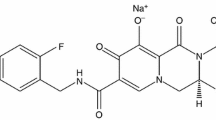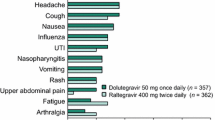Abstract
Darunavir (Prezista®), administered in combination with ritonavir and background antiretroviral therapy, is approved in the USA and the EU for the treatment of HIV-1 infection in pediatric patients aged ≥3 years. Ritonavir-boosted darunavir provided effective virologic suppression in treatment-naïve adolescents with HIV-1 infection, according to the results of the noncomparative, phase II DIONE trial. Ritonavir-boosted darunavir also had sustained efficacy in treatment-experienced children and/or adolescents with HIV-1 infection, according to the results of the noncomparative, phase II DELPHI and ARIEL trials. Ritonavir-boosted darunavir was generally well tolerated in pediatric patients with HIV-1 infection. Although more data are needed in pediatric populations (particularly data comparing darunavir with other antiretroviral agents), ritonavir-boosted darunavir is an important option for the treatment of pediatric patients with HIV-1 infection.
Similar content being viewed by others
References
Dobroszycki J, Abadi J, Wiznia AA, et al. Profile of darunavir in the treatment of HIV-infected pediatric and adolescent patients. Adolesc Health Med Ther. 2011;2:85–93.
European Medicines Agency. Prezista (darunavir): EU summary of product characteristics. 2014. http://www.ema.europa.eu. Accessed 30 July 2015.
Janssen Pharmaceuticals Inc. Prezista (darunavir): US prescribing information. 2015. http://www.prezista.com. Accessed 30 July 2015.
Deeks ED. Darunavir: a review of its use in the management of HIV-1 infection. Drugs. 2014;74(1):99–125.
Flynn P, Komar S, Blanche S, et al. Efficacy and safety of darunavir/ritonavir at 48 weeks in treatment-naive, HIV-1-infected adolescents: results from a phase 2 open-label trial (DIONE). Pediatr Infect Dis J. 2014;33(9):940–5.
Blanche S, Bologna R, Cahn P, et al. Pharmacokinetics, safety and efficacy of darunavir/ritonavir in treatment-experienced children and adolescents. AIDS. 2009;23(15):2005–13.
Violari A, Bologna R, Kumarasamy N, et al. Safety and efficacy of darunavir/ritonavir in treatment-experienced pediatric patients: week 48 results of the ARIEL trial. Pediatr Infect Dis J. 2015;34(5):e132–7.
Koh Y, Matsumi S, Das D, et al. Potent inhibition of HIV-1 replication by novel non-peptidyl small molecule inhibitors of protease dimerization. J Biol Chem. 2007;282(39):28709–20.
King NM, Prabu-Jeyabalan M, Nalivaika EA, et al. Structural and thermodynamic basis for the binding of TMC114, a next-generation human immunodeficiency virus type 1 protease inhibitor. J Virol. 2004;78(21):12012–21.
Nivesanond K, Peeters A, Lamoen D, et al. Conformational analysis of TMC114, a novel HIV-1 protease inhibitor. J Chem Inf Model. 2008;48(1):99–108.
Dierynck I, De Wit M, Gustin E, et al. Binding kinetics of darunavir to human immunodeficiency virus type 1 protease explain the potent antiviral activity and high genetic barrier. J Virol. 2007;81(24):13845–51.
Koh Y, Aoki M, Danish ML, et al. Loss of protease dimerization inhibition activity of darunavir is associated with the acquisition of resistance to darunavir by HIV-1. J Virol. 2011;85(19):10079–89.
De Meyer S, Azijn H, Surleraux D, et al. TMC114, a novel human immunodeficiency virus type 1 protease inhibitor active against protease inhibitor-resistant viruses, including a broad range of clinical isolates. Antimicrob Agents Chemother. 2005;49(6):2314–21.
Koh Y, Nakata H, Maeda K, et al. Novel bis-tetrahydrofuranylurethane-containing nonpeptidic protease inhibitor (PI) UIC-94017 (TMC114) with potent activity against multi-PI-resistant human immunodeficiency virus in vitro. Antimicrob Agents Chemother. 2003;47(10):3123–9.
Dierynck I, De Meyer S, Lathouwers E, et al. In vitro susceptibility and virological outcome to darunavir and lopinavir are independent of HIV type-1 subtype in treatment-naive patients. Antivir Ther. 2010;15(8):1161–9.
de Meyer S, Vangeneugden T, van Baelen B, et al. Resistance profile of darunavir: combined 24-week results from the POWER trials. AIDS Res Hum Retroviruses. 2008;24(3):379–88.
De Meyer S, Dierynck I, Lathouwers E, et al. Phenotypic and genotypic determinants of resistance to darunavir: analysis of data from treatment-experienced patients in POWER 1, 2, 3 and DUET-1 and 2 [abstract no. 31]. Antivir Ther. 2008;13(Suppl 3):A33.
De Meyer S, Lathouwers E, Dierynck I, et al. Characterization of virologic failure patients on darunavir/ritonavir in treatment-experienced patients. AIDS. 2009;23(14):1829–40.
Lathouwers E, De La Rosa G, Van de Casteele T, et al. Virological analysis of once-daily and twice-daily darunavir/ritonavir in the ODIN trial of treatment-experienced patients. Antivir Ther. 2013;18(3):289–300.
Lathouwers E, De Meyer S, Dierynck I, et al. Virological characterization of patients failing darunavir/ritonavir or lopinavir/ritonavir treatment in the ARTEMIS study: 96-week analysis. Antivir Ther. 2011;16(1):99–108.
Donegan KL, Walker AS, Dunn D, et al. The prevalence of darunavir-associated mutations in HIV-1-infected children in the UK. Antivir Ther. 2012;17(4):599–603.
Brochot A, Vis P, Van De Casteele T, et al. Model based dosing rationale for darunavir when co-administered with low-dose ritonavir in pediatric HIV-1 infected patients [abstract no. T-040 ]. J Pharmacokinet Pharmacodyn. 2013;40(1 Suppl):S89–S90.
Kakuda TN, Brochot A, van de Casteele T, et al. Establishing darunavir dosing recommendations in treatment-naive and treatment-experienced pediatric patients [abstract no. O_13]. In: 14th International Workshop on Clinical Pharmacology of HIV Therapy. 2013.
Kakuda TN, Sekar V, Lavreys L, et al. Pharmacokinetics of darunavir after administration of an oral suspension with low-dose ritonavir and with or without food. CPDD. 2014;3(5):346–52.
European Medicines Agency. Assessment report for Prezista (darunavir). Procedure no. EMEA/H/C/000707/X/0041/G. 2012. http://www.ema.europa.eu. Accessed 30 July 2015.
Schwarze-Zander C, Klingmüller D, Klümper J, et al. Triamcinolone and ritonavir leading to drug-induced Cushing syndrome and adrenal suppression: description of a new case and review of the literature. Infection. 2013;41(6):1183–7.
Larson KB, Cressey TR, Yogev R, et al. Pharmacokinetics of once-daily darunavir/ritonavir with and without etravirine in human immunodeficiency virus-infected children, adolescents, and young adults. J Pediatric Infect Dis Soc. 2015. doi:10.1093/jpids/piu142.
Rakhmanina NY, Neely MN, Capparelli EV. High dose of darunavir in treatment-experienced HIV-infected adolescent results in virologic suppression and improved CD4 cell count. Ther Drug Monit. 2012;34(3):237–41.
Bamford A, Turkova A, Lyall H, et al. Paediatric European Network for Treatment of AIDS (PENTA) guidelines for treatment of paediatric HIV-1 infection 2015: optimizing health in preparation for adult life. HIV Med. 2015. doi:10.1111/hiv.12217.
Panel on Antiretroviral Therapy and Medical Management of HIV-Infected Children. Guidelines for the use of antiretroviral agents in pediatric HIV infection. 2015. http://aidsinfo.nih.gov/contentfiles/lvguidelines/PediatricGuidelines.pdf. Accessed 30 July 2015.
World Health Organization. Antiretroviral therapy for HIV infection in infants and children: towards universal access. 2010. http://whqlibdoc.who.int/publications/2010/9789241599801_eng.pdf?ua=1. Accessed 30 July 2015.
Ananworanich J, Puthanakit T, Saphonn V, et al. Lessons from a multicentre paediatric HIV trial. Lancet. 2008;372(9636):356–7.
Panel on Antiretroviral Guidelines for Adults and Adolescents. Guidelines for the use of antiretroviral agents in HIV-1-infected adults and adolescents: Department of Health and Human Services. 2015. http://aidsinfo.nih.gov/guidelines/html/1/adult-and-adolescent-arv-guidelines/0. Accessed 30 July 2015.
Gilead Sciences Inc. Truvada® (emtricitabine/tenofovir disoproxil fumarate): US prescribing information. 2015. http://www.gilead.com. Accessed 30 July 2015.
European Medicines Agency. Truvada (tenofovir disoproxil fumarate/emtricitabine): EU summary of product characteristics. 2015. http://www.ema.europa.eu. Accessed 30 July 2015.
European Medicines Agency. Viread (tenofovir disoproxil fumarate): EU summary of product characteristics. 2015. http://www.ema.europa.eu. Accessed 30 July 2015.
European Medicines Agency. Emtriva (emtricitabine): EU summary of product characteristics. 2015. http://www.ema.europa.eu/. Accessed 30 July 2015.
Overton ET, Arathoon E, Baraldi E, et al. Effect of darunavir on lipid profile in HIV-infected patients. HIV Clin Trials. 2012;13(5):256–70.
Xiang N, James M, Walters S, et al. Improved serum cholesterol in paediatric patients switched from suppressive lopinavir-based therapy to boosted darunavir or atazanavir: an 18-month retrospective study. HIV Med. 2014;15(10):635–6.
Buijs BS, van den Berk GE, Boateng CP, et al. Cross-reactivity between darunavir and trimethoprim-sulfamethoxazole in HIV-infected patients. AIDS. 2015;29(7):785–91.
Rosso R, Bernardini C, Bruzzone B, et al. Efficacy and safety of darunavir and etravirine in an antiretroviral multi-experienced youth with vertically HIV-1 infection. Eur J Med Res. 2009;14(3):136–8.
Thuret I, Chaix M-L, Tamalet C, et al. Raltegravir, etravirine and r-darunavir combination in adolescents with multidrug-resistant virus. AIDS. 2009;23(17):2364–6.
Lin D, Seabrook JA, Matsui DM, et al. Palatability, adherence and prescribing patterns of antiretroviral drugs for children with human immunodeficiency virus infection in Canada. Pharmacoepidemiol Drug Saf. 2011;20(12):1246–52.
Kirk BL, Gomila A, Matshaba M, et al. Early outcomes of darunavir- and/or raltegravir-based antiretroviral therapy in children with multidrug-resistant HIV at a pediatric center in Botswana. J Int Assoc Provid AIDS Care. 2013;12(2):90–4.
Kindra G, Sipambo N, Moultrie H, et al. Outcomes in treatment with darunavir/ritonavir in ART-experienced paediatric patients [letter]. S Afr Med J. 2015;105(5):330–1.
Acknowledgments
During the peer review process, the manufacturer of darunavir was also offered an opportunity to review this article. Changes resulting from comments received were made on the basis of scientific and editorial merit.
Author information
Authors and Affiliations
Corresponding author
Ethics declarations
Funding
The preparation of this review was not supported by any external funding.
Conflict of interest
Gillian Keating is a salaried employee of Adis/Springer, is responsible for the article content and declares no relevant conflicts of interest.
Additional information
The manuscript was reviewed by: S. Blanche, Department of Pediatric Immuno-Hematology, Hôpital Necker-Enfants-Malades, Paris Descartes University, Paris, France; K. M. Butler, Department of Infectious Diseases and Immunology, Our Lady’s Children’s Hospital Crumlin & University College Dublin, Dublin, Ireland; B. S. Eley, Pediatric Infectious Diseases Unit, Red Cross Children’s Hospital, School of Child and Adolescent Health, University of Cape Town, Rondebosch, South Africa; V. Giacomet, Pediatric Infectious Diseases Unit, L. Sacco Hospital, University of Milan, Milan, Italy; P. Nannini, Pediatric Infectious Diseases Unit, L. Sacco Hospital, Milan, Italy; A. Noguera-Julian, Infectious Disease Unit, Pediatrics Department, Hospital Sant Joan de Déu, Universitat de Barcelona, Barcelona, Spain.
Rights and permissions
About this article
Cite this article
Keating, G.M. Darunavir: A Review in Pediatric HIV-1 Infection. Pediatr Drugs 17, 411–421 (2015). https://doi.org/10.1007/s40272-015-0146-0
Published:
Issue Date:
DOI: https://doi.org/10.1007/s40272-015-0146-0




